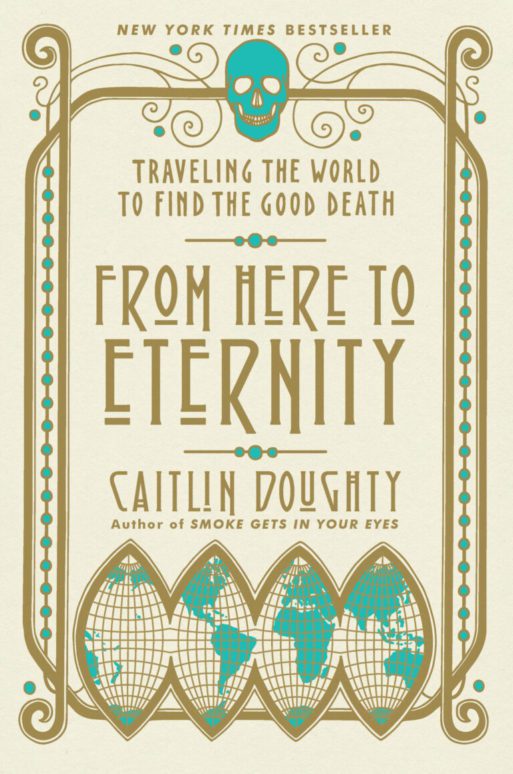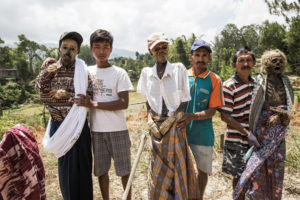 “From Here To Eternity” by Caitlin Doughty is a fascinating look at funerary practices from around the world. Doughty, herself a funeral home owner, was inspired to witness how death is dealt with in other cultures. She wanted to show that there is no one, correct way to understand or deal with the deaths of our loved ones.
“From Here To Eternity” by Caitlin Doughty is a fascinating look at funerary practices from around the world. Doughty, herself a funeral home owner, was inspired to witness how death is dealt with in other cultures. She wanted to show that there is no one, correct way to understand or deal with the deaths of our loved ones.
She weaves historical narratives among vivid descriptions of the various cultural practices she was able to witness firsthand. Throughout the book, she compares these methods/ceremonies of caring for the dead to our own practices here in the United States. And the differences can be quite striking.
Doughty poignantly questions whether American funeral rites as they are practiced now actually serve the bereaved.
In fact, in her introduction to the book she writes:
One of the chief questions in my work has always been why my own culture is so squeamish around death. Why do we refuse to have these conversations, asking our family and friends what they want done with their body when they die? Our avoidance is self-defeating. By dodging the talk about our inevitable end, we put both our pocket-books and our ability to mourn at risk.
Doughty rightfully states that it is wrong for us to think that our Western rituals related to death are superior to the rest of world. She also believes that we have fallen behind many cultures regarding “proximity, intimacy, and ritual around death.”
Death And Travel
“From Here To Eternity” could in one sense be classified as a travel book with an emphasis on death and dying. Each chapter is named after the country or U.S. state where she witnessed a different death ritual. For instance, in the “Indonesia” chapter she discusses two different ceremonies dealing with the dead.
First, she describes a funeral she witnessed in the Tana Toraja Regency. (Tana Toraja is home to the Toraja ethnic group. Doughty attended a Torajan funeral.) Accompanied by beating drums and crashing cymbals, the corpse of the person who had died was placed in a replica of a traditional Torajan house. The mini-house was subsequently carried by 35 men, who transported this “coffin” into a courtyard surrounded by a crowd of people.
Without giving too much away, one of the main differences between Torajan and American death cultures Doughty points out is the time table in which they deal with the dead. The man being honored during the funeral she describes had died three months earlier.
In Toraja, the body is kept in the family residence between the time of death and the funeral. Sometimes, people who have died can stay in their loved ones’ homes for years as the living family cares for and mummifies the body. The family will also change the corpse’s clothes and talk to them.
The people who have died during this time are not truly dead yet in Torajan culture. Not breathing, of course, but they are more in a kind of fever-like state. The illness ends when an animal is sacrificed, which will come to signify the person’s final breath.

During the ma’nene’ ritual, native Torajans in Indonesia bring out their mummified loved ones The ceremony occurs every few years.
Credit: sea-globe.com
Doughty also describes the ma’nene’ tradition, during which mummified bodies of people who have died (some of whom died many years ago) are brought out of their house-graves. During this time, the living family members interact with the corpse. Some take family photos, others have picnics with their loved ones who have died; it’s as if the family is being reunited with their loved one.
This would undoubtedly cause most Americans to recoil, but it’s one way in which the Torajan people pay tribute to their loved ones and stay connected with them, something Doughty thinks is very important.
These are just two brief summaries of the many different cultures’ death rituals discussed in the book. “From Here To Eternity” takes us from Indonesia to Japan, Colorado to North Carolina, Mexico to Bolivia, and a host of other places around the world.
Historical Lessons
Doughty teaches readers not only about different cultures and their views of death and dying. She also provides historical context for many of the death rituals she describes.
For example, early in the book she gives a brief history of industrial cremation. According to Doughty, industrial furnace cremation originated in Europe in the late 19th century. She goes on to describe why it was created, and how and where the cremation “movement” continued to develop.
In the “Mexico” chapter, Doughty recounts the historical significance and resurgence of the importance of the Dias de los Muertos. She mentions how the long-standing tradition began to fall out of favor with urbanites in Mexico during the early 20th century. But over time, it has again become very symbolic of Mexico, representing in different ways popular Mexican culture, tourist culture and protest culture.
Final Thoughts
Doughty writes in a very fluid, easily-read manner. Throughout “From Here To Eternity” she uses humor to mitigate the sometimes bleak and even macabre descriptions. Yet she still treats the subject matter with a great deal of respect, despite the comedy. (There are many descriptions of decomposition and the like, so the comedic respites can certainly come in handy.)

Caitlin Doughty
Credit: orderofthegooddeath.com
There are also hand-drawn, black-and-white illustrations strewn throughout “From Here To Eternity” quite regularly. Drawn by Landis Blair, the illustrations help the reader visualize many of the vivid scenes Doughty describes. They are great additions to the anecdotes.
One of the more important takeaways from the book is that we should not avoid death. It’s inevitable, and the more we talk about it and acknowledge it, the better off we’ll be. Doughty writes, “We avoid the death that surrounds us at our own peril…Death avoidance is not an individual failing; it’s a cultural one.”
Doughty believes that it is crucial for American society to better engage in the process of death and dying. She calls for people to have a ring of safety while grieving. There are, but should not be, feelings of social shame when it comes to grief. She points to the fact that in Western culture, it is taboo and socially awkward to discuss death and grief, and people are oftentimes looked down upon if they openly talk about it.
Through her travels, Doughty found that every culture had their own way to be in touch with their dead in some way. And she believes we should be connected with our loved ones who have died, not separated from them. In essence, we need to participate in the process of caring for our loved ones after they have died.
“From Here To Eternity” meshes well with our goal here at SevenPonds. We want to foster an environment in which people can discuss death and dying openly, without fear of judgement. That being said, I highly recommend this book to any of our readers and anyone who is interested in how other cultures treat their loved ones who have died.

 “From Here To Eternity: Traveling The World In Search Of The Good Death,” by Caitlin Doughty
“From Here To Eternity: Traveling The World In Search Of The Good Death,” by Caitlin Doughty


 First the Wealth Gap, Now the U.S. Has a Growing Health Gap
First the Wealth Gap, Now the U.S. Has a Growing Health Gap
 How to Comfort A Dying Loved One
How to Comfort A Dying Loved One
 Our Annual Seven Holiday Gifts for Someone Who Is Grieving, 2024 Edition
Our Annual Seven Holiday Gifts for Someone Who Is Grieving, 2024 Edition














